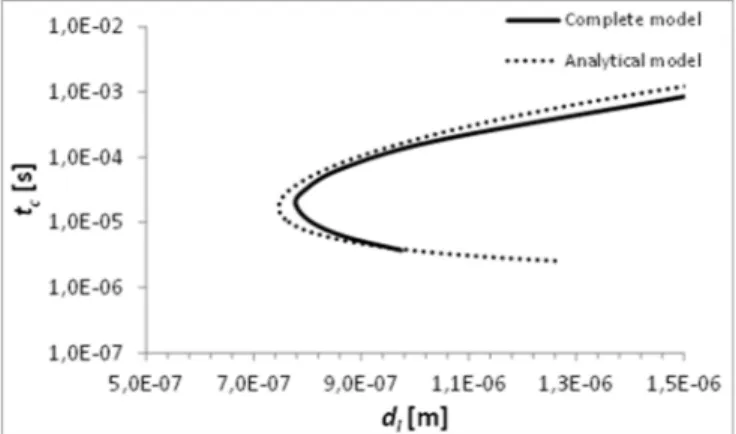Seventh International Symposium on TWO-PHASE SYSTEMS FOR GROUND AND SPACE APPLICATIONS, Beijing, China, September 17-21, 2012
Solutal Marangoni instability of binary mixtures evaporating into air: an analytical model
describing highly unstable cases
H.Machrafi1, A. Rednikov2, P. Colinet2, P.C. Dauby1 1
Université de Liège, Thermodynamique des Phénomènes Irréversibles, Institut de Physique B5a, Allée du 6 Août, 17, B-4000 Liège 1, Belgium
2
Université Libre de Bruxelles, TIPs – Fluid Physics, CP165/67, Avenue F.D. Roosevelt, 50, B-1050 Bruxelles, Belgium
Let us consider a horizontal binary mixture that evaporates into air. The evaporation process gives rise to the development of transient solute mass fraction profiles in both the liquid and gas phases. Here the reference solution is defined as the corresponding horizontally homogeneous base state where the liquid is at rest. After the beginning of evaporation, mass fraction or temperature gradients can trigger instabilities when a certain time threshold is surpassed. The purpose here is to find this critical time that marks the onset of instability as a function of the liquid thickness. Systems having a gas layer much larger than the liquid one are of primary concern in this work.
In our mathematical model of the system, the liquid layer is in contact with a gas layer. This gas layer thickness is given by a certain transfer distance above which a fully mixed gas is present whose mass fraction, pressure and temperature are controlled. A schematic representation of the system is given in Fig. 1.
Figure 1: Sketch of the system
In order to analyze the course of instability, infinitesimal perturbations are added to the reference solution of this model and the frozen-time approach is used (Machrafi et al. 2010, Machrafi et al. 2011). Even if the temperature profiles can be taken into consideration, as well as the Rayleigh and Soret effects, earlier studies (Machrafi et al. 2010, Machrafi et al. 2011) have pointed out that it is the solutal Marangoni effect that determines the onset of instability. Hence, only the solutal Marangoni mechanism is taken into consideration here.
When the gas thickness is much larger than the liquid one, the critical time for the onset of Marangoni instability proves to correspond to the moment when the mass fraction boundary layers are still far from the respective bottom liquid and top gas layers. The mass fraction reference solutions can then be approximated by an analytical auto-similar description, considering semi-infinite liquid and gas layers. As far as the perturbations are concerned, a special situation occurs. It appears that at the onset of instability, contrary to the reference boundary layers, the perturbations in the liquid reach the bottom of the liquid. The perturbations in the gas, though, are still far from the top of the gas. This gives rise to a new analytical
formulation for the instability onset. Hereby, the assumptions made in the Pearson-like model (described by Machrafi et al. 2010) are followed, albeit with a solutal Biot-like number that depends on the wavenumber.
In order to validate this model, it is compared to a complete model (Machrafi et al. 2012) that considers transient mass fraction and temperature profiles in both the liquid and gas layers, both thermal and solutal Rayleigh and Marangoni effects as well as the Soret effect. For comparison purposes the complete model and the one presented here are applied to the case of an aqueous solution of ethanol of which the ethanol mass fraction is 0.1. Atmospheric pressure is used at an initial temperature of 300 K (kept that way at the top and bottom as well). The mass fraction of water and ethanol at the top boundary is kept at zero.
Fig. 2 presents this comparison (with a gas to liquid layer thickness ratio of 101 for the complete model) on the basis of the critical time needed for instability onset as a function of the liquid thickness. It can be seen that the analytical model presented here, represents well the instability thresholds for systems with a high gas to liquid layer thickness where the instability threshold occurs very early in the evaporation process.
Figure 2: Comparison of the complete model with the
analytical model
References
H. Machrafi, A. Rednikov, P. Colinet, P.C. Dauby, Bénard instabilities in a binary-liquid layer evaporating into an inert gas, J. Colloid Interf. Sc., Vol. 349 pp. 331-353 (2010) H. Machrafi, A. Rednikov, P. Colinet, P.C. Dauby, Bénard instabilities in a binary-liquid layer evaporating into an inert gas: stability of quasi-stationary and time-dependent reference profiles, Europ. Phys. J., Vol. 192 pp. 71-81 (2011) H. Machrafi, A. Rednikov, P. Colinet, P.C. Dauby, to be
